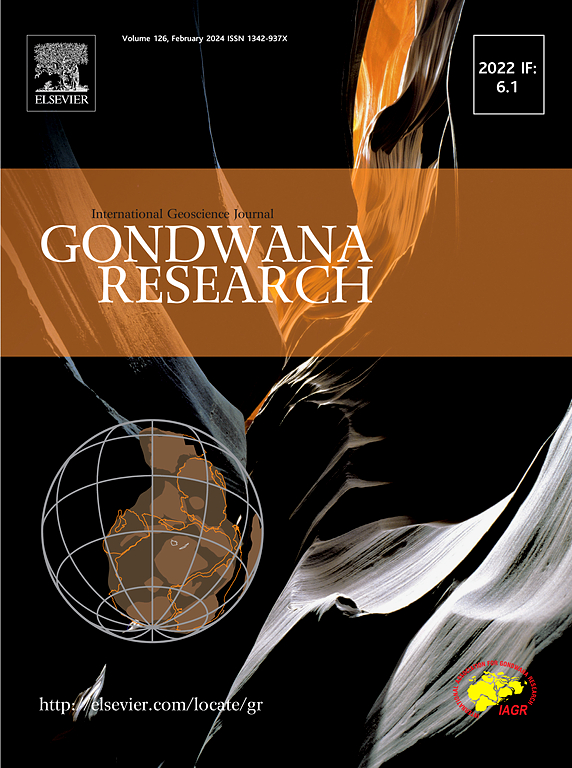Divergent subduction of a tearing slab controls deep carbon recycling efficiency: Helium and carbon isotopic evidence from the southeast Tibetan Plateau
IF 7.2
1区 地球科学
Q1 GEOSCIENCES, MULTIDISCIPLINARY
引用次数: 0
Abstract
Variations of helium isotopic compositions across tectonic belts and at regional scales provide critical insights into crust–mantle interactions and the transport of heat and volatiles from the Earth’s interior. In this study, we report geochemical data from 26 thermal springs, including 51 newly analyzed samples, and integrate a broader dataset comprising 854 samples from 350 sites distributed along the Xianshuihe and Red River fault zones of southeastern Tibetan Plateau. Distinct helium isotopic anomalies and heterogeneous contributions of recycled carbon sourced from altered oceanic crust (AOC) were identified using combined analyses of 3He/4He ratios and δ13C–CO2 signatures, supported by an updated helium–carbon coupling model. Clear spatial contrasts were observed across the helium boundary zone (HBZ), with δ13C–CO2 and CO2/3He ratios revealing marked differences between the northwestern and southeastern sectors. The mantle-derived helium-3 flux reaches approximately 1.7 × 104 atoms m−2 s−1 in the northwest, compared with 1.04 × 104 atoms m−2 s−1 in the southeast. These disparities align closely with geophysical evidence indicating the presence of a slab tear in the Indian lithosphere beneath the Lijiang–Xiaojinhe fault (LXF). In addition, a decarbonation boundary linked to slab subduction was delineated near 26°N with higher recycled carbon fluxes in the northwest (∼35 %) than those in the southeast (∼22 %). This asymmetry is attributed to variations of subduction depth and angle associated with tearing of the Indian slab. The results of this study highlight the pivotal role of slab tearing and divergent subduction processes in modulating the efficiency and spatial heterogeneity of deep carbon recycling along convergent plate margins.

撕裂板的发散俯冲控制着青藏高原东南部深层碳循环效率:氦和碳同位素证据
在构造带和区域尺度上,氦同位素组成的变化为地壳-地幔相互作用以及地球内部热量和挥发物的传输提供了重要的见解。在这项研究中,我们报告了26个温泉的地球化学数据,其中包括54个新分析的样本,并整合了分布在青藏高原东南部鲜水河和红河断裂带350个地点的854个样本。通过对3He/4He比值和δ13C-CO2特征的综合分析,在更新的氦-碳耦合模型的支持下,确定了明显的氦同位素异常和来自蚀变洋壳(AOC)的再生碳的非均质贡献。在整个氦边界带(HBZ)上,δ13C-CO2和CO2/3He比值在西北和东南扇区之间存在明显差异。幔源氦- 3通量达到大约1.7 ×104 原子 m−2 s−1在西北方向,相对于1.04 × 104 原子 −2 s−1在东南部。这些差异与表明丽江-小金河断裂(LXF)下印度岩石圈存在板块撕裂的地球物理证据密切相关。此外,在26°N附近圈定了一个与板块俯冲有关的脱碳边界,西北地区的再生碳通量(~ 35 %)高于东南地区(~ 22 %)。这种不对称性归因于与印度板块撕裂有关的俯冲深度和俯冲角度的变化。研究结果强调了板块撕裂和发散性俯冲过程在调节板块边缘深部碳循环效率和空间异质性中的关键作用。
本文章由计算机程序翻译,如有差异,请以英文原文为准。
求助全文
约1分钟内获得全文
求助全文
来源期刊

Gondwana Research
地学-地球科学综合
CiteScore
12.90
自引率
6.60%
发文量
298
审稿时长
65 days
期刊介绍:
Gondwana Research (GR) is an International Journal aimed to promote high quality research publications on all topics related to solid Earth, particularly with reference to the origin and evolution of continents, continental assemblies and their resources. GR is an "all earth science" journal with no restrictions on geological time, terrane or theme and covers a wide spectrum of topics in geosciences such as geology, geomorphology, palaeontology, structure, petrology, geochemistry, stable isotopes, geochronology, economic geology, exploration geology, engineering geology, geophysics, and environmental geology among other themes, and provides an appropriate forum to integrate studies from different disciplines and different terrains. In addition to regular articles and thematic issues, the journal invites high profile state-of-the-art reviews on thrust area topics for its column, ''GR FOCUS''. Focus articles include short biographies and photographs of the authors. Short articles (within ten printed pages) for rapid publication reporting important discoveries or innovative models of global interest will be considered under the category ''GR LETTERS''.
 求助内容:
求助内容: 应助结果提醒方式:
应助结果提醒方式:


